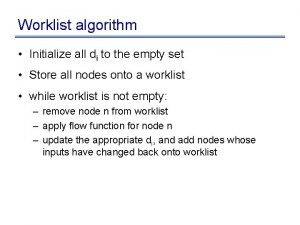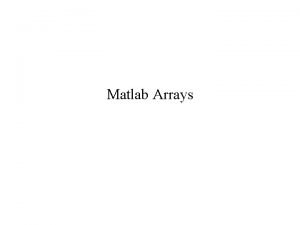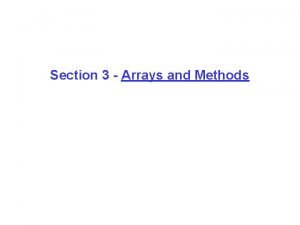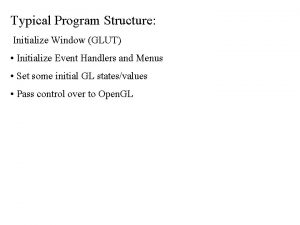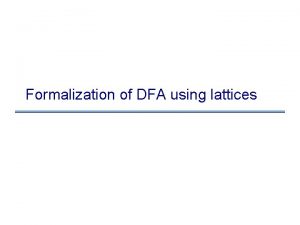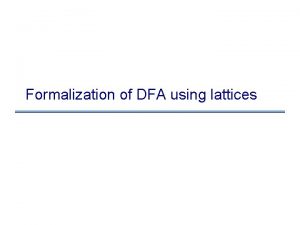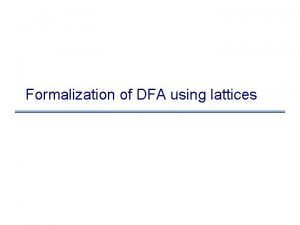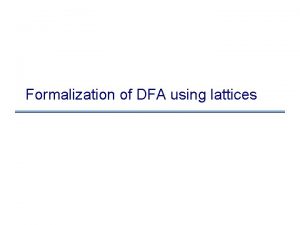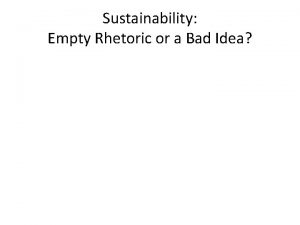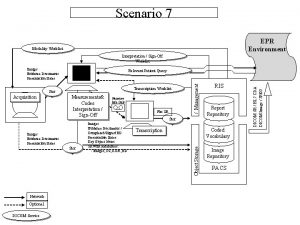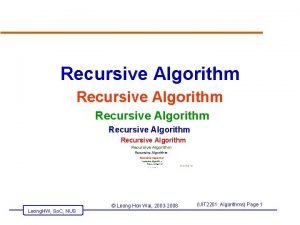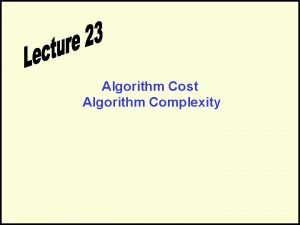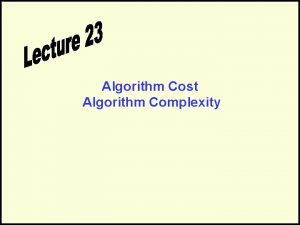Worklist algorithm Initialize all di to the empty


























































![Another example: constant prop in s: if (. . . ) out[0] out[1] in[0] Another example: constant prop in s: if (. . . ) out[0] out[1] in[0]](https://slidetodoc.com/presentation_image/b0ec7da9f8bf26c90ef21e12c87baae3/image-59.jpg)
- Slides: 59

Worklist algorithm • Initialize all di to the empty set • Store all nodes onto a worklist • while worklist is not empty: – remove node n from worklist – apply flow function for node n – update the appropriate di, and add nodes whose inputs have changed back onto worklist

Worklist algorithm let m: map from edge to computed value at edge let worklist: work list of nodes for each edge e in CFG do m(e) : = ; for each node n do worklist. add(n) while (worklist. empty. not) do let n : = worklist. remove_any; let info_in : = m(n. incoming_edges); let info_out : = F(n, info_in); for i : = 0. . info_out. length-1 do if (m(n. outgoing_edges[i]) info_out[i]) m(n. outgoing_edges[i]) : = info_out[i]; worklist. add(n. outgoing_edges[i]. dst);

Termination • Why is termination important? • Can we stop the algorithm in the middle and just say we’re done. . . • No: we need to run it to completion, otherwise the results are not safe. . .

Termination • Assuming we’re doing reaching defs, let’s try to guarantee that the worklist loop terminates, regardless of what the flow function F does while (worklist. empty. not) do let n : = worklist. remove_any; let info_in : = m(n. incoming_edges); let info_out : = F(n, info_in); for i : = 0. . info_out. length-1 do if (m(n. outgoing_edges[i]) info_out[i]) m(n. outgoing_edges[i]) : = info_out[i]; worklist. add(n. outgoing_edges[i]. dst);

Termination • Assuming we’re doing reaching defs, let’s try to guarantee that the worklist loop terminates, regardless of what the flow function F does while (worklist. empty. not) do let n : = worklist. remove_any; let info_in : = m(n. incoming_edges); let info_out : = F(n, info_in); for i : = 0. . info_out. length-1 do let new_info : = m(n. outgoing_edges[i]) [ info_out[i]; if (m(n. outgoing_edges[i]) new_info]) m(n. outgoing_edges[i]) : = new_info; worklist. add(n. outgoing_edges[i]. dst);

Structure of the domain • We’re using the structure of the domain outside of the flow functions • In general, it’s useful to have a framework that formalizes this structure • We will use lattices

Background material

Relations • A relation over a set S is a set R µ S £ S – We write a R b for (a, b) 2 R • A relation R is: – reflexive iff 8 a 2 S. a. Ra – transitive iff 8 a 2 S, b 2 S, c 2 S. a R b Æ b R c ) a R c – symmetric iff 8 a, b 2 S. a R b ) b R a – anti-symmetric iff 8 a, b, 2 S. a R b ) : (b R a)

Relations • A relation over a set S is a set R µ S £ S – We write a R b for (a, b) 2 R • A relation R is: – reflexive iff 8 a 2 S. a. Ra – transitive iff 8 a 2 S, b 2 S, c 2 S. a R b Æ b R c ) a R c – symmetric iff 8 a, b 2 S. a R b ) b R a – anti-symmetric iff 8 a, b, 2 S. a R b ) : (b R a) 8 a, b, 2 S. a R b Æ b R a ) a = b

Partial orders • An equivalence class is a relation that is: • A partial order is a relation that is:

Partial orders • An equivalence class is a relation that is: – reflexive, transitive, symmetric • A partial order is a relation that is: – reflexive, transitive, anti-symmetric • A partially ordered set (a poset) is a pair (S, ·) of a set S and a partial order · over the set • Examples of posets: (2 S, µ), (Z, ·), (Z, divides)

Lub and glb • Given a poset (S, ·), and two elements a 2 S and b 2 S, then the: – least upper bound (lub) is an element c such that a · c, b · c, and 8 d 2 S. (a · d Æ b · d) ) c · d – greatest lower bound (glb) is an element c such that c · a, c · b, and 8 d 2 S. (d · a Æ d · b) ) d · c

Lub and glb • Given a poset (S, ·), and two elements a 2 S and b 2 S, then the: – least upper bound (lub) is an element c such that a · c, b · c, and 8 d 2 S. (a · d Æ b · d) ) c · d – greatest lower bound (glb) is an element c such that c · a, c · b, and 8 d 2 S. (d · a Æ d · b) ) d · c • lub and glb don’t always exists:

Lub and glb • Given a poset (S, ·), and two elements a 2 S and b 2 S, then the: – least upper bound (lub) is an element c such that a · c, b · c, and 8 d 2 S. (a · d Æ b · d) ) c · d – greatest lower bound (glb) is an element c such that c · a, c · b, and 8 d 2 S. (d · a Æ d · b) ) d · c • lub and glb don’t always exists:

Lattices • A lattice is a tuple (S, v, ? , >, t, u) such that: – – – (S, v) is a poset 8 a 2 S. ? va 8 a 2 S. av> Every two elements from S have a lub and a glb t is the least upper bound operator, called a join u is the greatest lower bound operator, called a meet

Examples of lattices • Powerset lattice

Examples of lattices • Powerset lattice

Examples of lattices • Booleans expressions

Examples of lattices • Booleans expressions

Examples of lattices • Booleans expressions

Examples of lattices • Booleans expressions

End of background material

Back to our example let m: map from edge to computed value at edge let worklist: work list of nodes for each edge e in CFG do m(e) : = ; for each node n do worklist. add(n) while (worklist. empty. not) do let n : = worklist. remove_any; let info_in : = m(n. incoming_edges); let info_out : = F(n, info_in); for i : = 0. . info_out. length do let new_info : = m(n. outgoing_edges[i]) [ info_out[i]; if (m(n. outgoing_edges[i]) new_info]) m(n. outgoing_edges[i]) : = new_info; worklist. add(n. outgoing_edges[i]. dst);

Back to our example • We formalize our domain with a powerset lattice • What should be top and what should be bottom?

Back to our example • We formalize our domain with a powerset lattice • What should be top and what should be bottom? • Does it matter? – It matters because, as we’ve seen, there is a notion of approximation, and this notion shows up in the lattice

Direction of lattice • Unfortunately: – dataflow analysis community has picked one direction – abstract interpretation community has picked the other • We will work with the abstract interpretation direction • Bottom is the most precise (optimistic) answer, Top the most imprecise (conservative)

Direction of lattice • Always safe to go up in the lattice • Can always set the result to > • Hard to go down in the lattice • So. . . Bottom will be the empty set in reaching defs

Worklist algorithm using lattices let m: map from edge to computed value at edge let worklist: work list of nodes for each edge e in CFG do m(e) : = ? for each node n do worklist. add(n) while (worklist. empty. not) do let n : = worklist. remove_any; let info_in : = m(n. incoming_edges); let info_out : = F(n, info_in); for i : = 0. . info_out. length do let new_info : = m(n. outgoing_edges[i]) t info_out[i]; if (m(n. outgoing_edges[i]) new_info]) m(n. outgoing_edges[i]) : = new_info; worklist. add(n. outgoing_edges[i]. dst);

Termination of this algorithm? • For reaching definitions, it terminates. . . • Why? – lattice is finite • Can we loosen this requirement? – Yes, we only require the lattice to have a finite height • Height of a lattice: length of the longest ascending or descending chain • Height of lattice (2 S, µ) =

Termination of this algorithm? • For reaching definitions, it terminates. . . • Why? – lattice is finite • Can we loosen this requirement? – Yes, we only require the lattice to have a finite height • Height of a lattice: length of the longest ascending or descending chain • Height of lattice (2 S, µ) = | S |

Termination • Still, it’s annoying to have to perform a join in the worklist algorithm while (worklist. empty. not) do let n : = worklist. remove_any; let info_in : = m(n. incoming_edges); let info_out : = F(n, info_in); for i : = 0. . info_out. length do let new_info : = m(n. outgoing_edges[i]) t info_out[i]; if (m(n. outgoing_edges[i]) new_info]) m(n. outgoing_edges[i]) : = new_info; worklist. add(n. outgoing_edges[i]. dst); • It would be nice to get rid of it, if there is a property of the flow functions that would allow us to do so

Even more formal • To reason more formally about termination and precision, we re-express our worklist algorithm mathematically • We will use fixed points to formalize our algorithm

Fixed points • Recall, we are computing m, a map from edges to dataflow information • Define a global flow function F as follows: F takes a map m as a parameter and returns a new map m’, in which individual local flow functions have been applied

Fixed points • We want to find a fixed point of F, that is to say a map m such that m = F(m) • Approach to doing this? • Define ? , which is ? lifted to be a map: ? = e. ? • Compute F(? ), then F(F(? )), then F(F(F(? ))), . . . until the result doesn’t change anymore

Fixed points • Formally: • We would like the sequence Fi(? ) for i = 0, 1, 2. . . to be increasing, so we can get rid of the outer join • Require that F be monotonic: – 8 a, b. a v b ) F(a) v F(b)

Fixed points

Fixed points

Back to termination • So if F is monotonic, we have what we want: finite height ) termination, without the outer join • Also, if the local flow functions are monotonic, then global flow function F is monotonic

Another benefit of monotonicity • Suppose Marsians came to earth, and miraculously give you a fixed point of F, call it fp. • Then:

Another benefit of monotonicity • Suppose Marsians came to earth, and miraculously give you a fixed point of F, call it fp. • Then:

Another benefit of monotonicity • We are computing the least fixed point. . .

Recap • Let’s do a recap of what we’ve seen so far • Started with worklist algorithm for reaching definitions

Worklist algorithm for reaching defns let m: map from edge to computed value at edge let worklist: work list of nodes for each edge e in CFG do m(e) : = ; for each node n do worklist. add(n) while (worklist. empty. not) do let n : = worklist. remove_any; let info_in : = m(n. incoming_edges); let info_out : = F(n, info_in); for i : = 0. . info_out. length do let new_info : = m(n. outgoing_edges[i]) [ info_out[i]; if (m(n. outgoing_edges[i]) new_info]) m(n. outgoing_edges[i]) : = new_info; worklist. add(n. outgoing_edges[i]. dst);

Generalized algorithm using lattices let m: map from edge to computed value at edge let worklist: work list of nodes for each edge e in CFG do m(e) : = ? for each node n do worklist. add(n) while (worklist. empty. not) do let n : = worklist. remove_any; let info_in : = m(n. incoming_edges); let info_out : = F(n, info_in); for i : = 0. . info_out. length do let new_info : = m(n. outgoing_edges[i]) t info_out[i]; if (m(n. outgoing_edges[i]) new_info]) m(n. outgoing_edges[i]) : = new_info; worklist. add(n. outgoing_edges[i]. dst);

Next step: removed outer join • Wanted to remove the outer join, while still providing termination guarantee • To do this, we re-expressed our algorithm more formally • We first defined a “global” flow function F, and then expressed our algorithm as a fixed point computation

Guarantees • If F is monotonic, don’t need outer join • If F is monotonic and height of lattice is finite: iterative algorithm terminates • If F is monotonic, the fixed point we find is the least fixed point. • Any questions so far?

What about if we start at top? • What if we start with >: F(>), F(F(>)), F(F(F(>)))

What about if we start at top? • What if we start with >: F(>), F(F(>)), F(F(F(>))) • We get the greatest fixed point • Why do we prefer the least fixed point? – More precise

Graphically y 10 10 x

Graphically y 10 10 x

Graphically y 10 10 x

Graphically, another way

Another example: constant prop • Set D = in x : = N Fx : = N(in) = out in x : = y op z out Fx : = y op z(in) =

Another example: constant prop • Set D = 2 { x ! N | x 2 Vars Æ N 2 Z } in x : = N Fx : = N(in) = in – { x ! * } [ { x ! N } out in x : = y op z out Fx : = y op z(in) = in – { x ! * } [ { x ! N | ( y ! N 1 ) 2 in Æ ( z ! N 2 ) 2 in Æ N = N 1 op N 2 }

Another example: constant prop in x : = *y Fx : = *y(in) = out in *x : = y out F*x : = y(in) =

Another example: constant prop in x : = *y out in *x : = y out Fx : = *y(in) = in – { x ! * } [ { x ! N | 8 z 2 may-point-to(x). (z ! N) 2 in } F*x : = y(in) = in – { z ! * | z 2 may-point(x) } [ { z ! N | z 2 must-point-to(x) Æ y ! N 2 in } [ { z ! N | (y ! N) 2 in Æ (z ! N) 2 in }

Another example: constant prop in *x : = *y + *z F*x : = *y + *z(in) = out in x : = f(. . . ) out Fx : = f(. . . )(in) =

Another example: constant prop in *x : = *y + *z F*x : = *y + *z(in) = Fa : = *y; b : = *z; c : = a + b; *x : = c(in) out in x : = f(. . . ) out Fx : = f(. . . )(in) = ;
![Another example constant prop in s if out0 out1 in0 Another example: constant prop in s: if (. . . ) out[0] out[1] in[0]](https://slidetodoc.com/presentation_image/b0ec7da9f8bf26c90ef21e12c87baae3/image-59.jpg)
Another example: constant prop in s: if (. . . ) out[0] out[1] in[0] in[1] merge out
 Worklist algorithm
Worklist algorithm Freedom worklist
Freedom worklist Balanced scorecard evolution
Balanced scorecard evolution Matlab array initialize
Matlab array initialize C# initialize multidimensional array
C# initialize multidimensional array Name all the lines name all the segments name all the rays
Name all the lines name all the segments name all the rays Hananel hazan
Hananel hazan Adrie wessels
Adrie wessels Hình ảnh bộ gõ cơ thể búng tay
Hình ảnh bộ gõ cơ thể búng tay Ng-html
Ng-html Bổ thể
Bổ thể Tỉ lệ cơ thể trẻ em
Tỉ lệ cơ thể trẻ em Chó sói
Chó sói Tư thế worm breton là gì
Tư thế worm breton là gì Chúa yêu trần thế
Chúa yêu trần thế Kể tên các môn thể thao
Kể tên các môn thể thao Thế nào là hệ số cao nhất
Thế nào là hệ số cao nhất Các châu lục và đại dương trên thế giới
Các châu lục và đại dương trên thế giới Cong thức tính động năng
Cong thức tính động năng Trời xanh đây là của chúng ta thể thơ
Trời xanh đây là của chúng ta thể thơ Cách giải mật thư tọa độ
Cách giải mật thư tọa độ 101012 bằng
101012 bằng Phản ứng thế ankan
Phản ứng thế ankan Các châu lục và đại dương trên thế giới
Các châu lục và đại dương trên thế giới Thể thơ truyền thống
Thể thơ truyền thống Quá trình desamine hóa có thể tạo ra
Quá trình desamine hóa có thể tạo ra Một số thể thơ truyền thống
Một số thể thơ truyền thống Cái miệng nó xinh thế chỉ nói điều hay thôi
Cái miệng nó xinh thế chỉ nói điều hay thôi Vẽ hình chiếu vuông góc của vật thể sau
Vẽ hình chiếu vuông góc của vật thể sau Nguyên nhân của sự mỏi cơ sinh 8
Nguyên nhân của sự mỏi cơ sinh 8 đặc điểm cơ thể của người tối cổ
đặc điểm cơ thể của người tối cổ Ví dụ giọng cùng tên
Ví dụ giọng cùng tên Vẽ hình chiếu đứng bằng cạnh của vật thể
Vẽ hình chiếu đứng bằng cạnh của vật thể Phối cảnh
Phối cảnh Thẻ vin
Thẻ vin đại từ thay thế
đại từ thay thế điện thế nghỉ
điện thế nghỉ Tư thế ngồi viết
Tư thế ngồi viết Diễn thế sinh thái là
Diễn thế sinh thái là Các loại đột biến cấu trúc nhiễm sắc thể
Các loại đột biến cấu trúc nhiễm sắc thể Số nguyên tố là số gì
Số nguyên tố là số gì Tư thế ngồi viết
Tư thế ngồi viết Lời thề hippocrates
Lời thề hippocrates Thiếu nhi thế giới liên hoan
Thiếu nhi thế giới liên hoan ưu thế lai là gì
ưu thế lai là gì Hổ đẻ mỗi lứa mấy con
Hổ đẻ mỗi lứa mấy con Khi nào hổ mẹ dạy hổ con săn mồi
Khi nào hổ mẹ dạy hổ con săn mồi Hệ hô hấp
Hệ hô hấp Từ ngữ thể hiện lòng nhân hậu
Từ ngữ thể hiện lòng nhân hậu Thế nào là mạng điện lắp đặt kiểu nổi
Thế nào là mạng điện lắp đặt kiểu nổi Which fits best in the empty box above?
Which fits best in the empty box above? Questions about the cask of amontillado
Questions about the cask of amontillado It is a huge nothing that we fear
It is a huge nothing that we fear Section of skin diagram
Section of skin diagram Apley compression test
Apley compression test Improper subset
Improper subset Telogen phase definition forensics
Telogen phase definition forensics Prolog
Prolog Empty bunch spreader
Empty bunch spreader Imsafe
Imsafe
